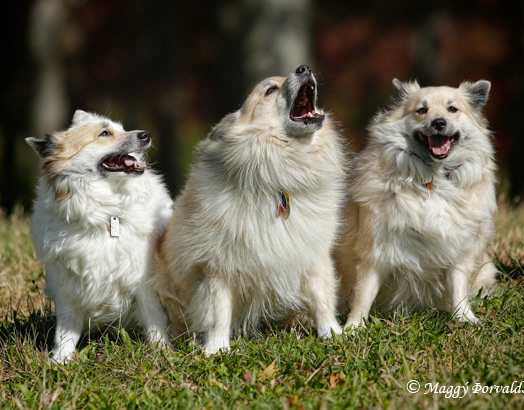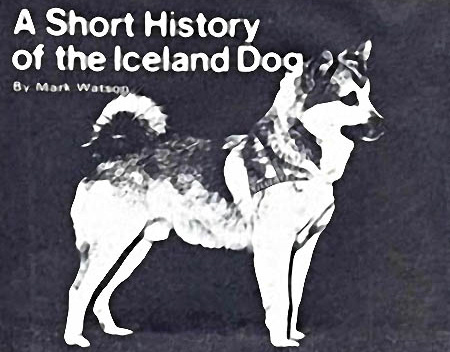This is how beautifully an Icelander once described the Icelandic Sheepdog, and he's so right: "The dog fits, in every way, perfectly into the nature of Iceland and naturally becomes a part of it." This love and admiration for the breed spurred my call for cooperation in order to preserve the Icelandic Sheepdog in its original form.
Since the 1970s, I have tried to follow the breed's development both in Iceland and in Scandinavia. All in all, it's been an interesting and educational experience! There were quite a few types of dogs: big and small, strong and slender, long-haired and short-haired, and they covered almost the whole color spectrum. But the common feature was their gentle and friendly nature. I think the reason for the great variation in type was that the Icelandic farmers emphasized useful characteristics more than physical appearance. An example is the old myth that dogs with double dew claws were better sheep dogs than others. Myths like this probably had some influence on which dogs were selected for breeding.
There's an interesting story about a farmer known for his excellent sheep dogs. Everyone wanted puppies from every litter he bred. But not everyone had good results using the dogs with their sheep. Someone asked him why it was that his own dogs always performed well. The farmer replied,
"It's not a secret that many of the owners don't have the intelligence of their dog."
"It's not a secret that many of the owners don't have the intelligence of their dog."
At dog shows in the early days, many different types of dogs were on display, and many judges struggled to learn what type of dog was considered correct. Today, the hard work that has gone into defining the correct type of Icelandic Sheepdog has paid off. It's now much easier to identify correct type among the dogs participating in shows.
Before the club in Denmark was formed, the breed was represented in Dansk Kennel Klub (the largest organization for dog owners in Denmark and the one cooperating with FCI) by Susanne Frohn Nielsen. Susanne was one of the pioneers in Denmark and did fantastic work for the breed as a whole. Not only did she breed dogs herself under the kennel name Skovriddergaarden, she advised other breeders and has had a great influence on the Icelandic Sheepdog and its development in Denmark.
Over the years, it became obvious to me that we needed international cooperation to preserve the Icelandic Sheepdog. I felt this was necessary if we wanted to preserve the breed's characteristics, health and appearance.
Bearing in mind the very limited gene pool available, I saw that breeding without a plan would result in different types and temperament, changing the original type and appearance of the breed -- or, in the worst-case scenario, jeopardizing the existence of the breed as a whole.
In the mid-1990s, this happened in Iceland. An association, Fjári, was formed to sell dogs for export as a source of revenue for Icelandic farmers. This was a completely new reason for breeding dogs. It lead to a confrontation between the farmers' association and both the Icelandic dog owners' association (HRFI) and the Icelandic Sheepdog association (DIF). Both breed organizations strongly opposed breeding dogs as a revenue source for farmers. As chairman of both HRFI and DIF, I realized that the time for a serious call for international cooperation had come.
My good friend Hans-Åke Sperne was an enormous help to me during this period. He contacted all of the breed representatives in Scandinavia, including the national kennel clubs, explaining the need for international cooperation. To make a long story short, the official Icelandic Sheepdog International Committee (ISIC) met for the first time in 1996 in Bjuv, Sweden. Since then we have successfully cooperated as friends, with respect for each other and as unified representatives of the breed across borders.
However, it is sad to see that some people still want to create clubs that conflict with the FCI. It seems they don't want to work in the best interests of the Icelandic Sheepdog. These breeders seem to want to follow their own direction with their dogs, resulting in the loss of genetic material from the gene pool as a whole as they breed following rules that have been set independently of the international community. But their dogs can provide genetic material that is desperately needed for the breed's further development and preservation.
In 10 years, the ISIC committee has managed to collect information about the Icelandic Sheepdog in a database. At ISIC's 10-year anniversary in 2006, Per Erik Sundgren said that this is a pioneering European endeavor that all breed enthusiasts should be proud of!
Today, the database includes information about nearly 8,500 Icelandic Sheepdogs. A result of the groundbreaking work done, the rate of inbreeding has dropped from 18 percent to 4.6 percent. In Denmark, the inbreeding coefficient is down to approximately 1.5 percent.
I'd also like to mention that we owe our two geneticists -- Per-Erik Sundgren from Sweden and Pieter Oliehoek from the Netherlands -- our deepest respect for their dedication to and work for both ISIC and the Icelandic Sheepdog. Without their efforts, we wouldn't have had the information that we have today.
The Icelandic Sheepdog bonds very strongly to its "human flock" and flourishes when allowed associate closely with human beings. The dogs are true members of the group, participating in everything it does. It has always been my opinion that it is destructive for an Icelandic Sheepdog to live its life as a kennel dog.
A living piece of art ought to live together freely with its human flock.
A living piece of art ought to live together freely with its human flock.
Prologue/Credits:
This article, written by Gudrun Ragnars Gudjohnsen , was originally published in the 10th-anniversary issue of
"Islandshunden," the club magazine of the Danish association of the Icelandic Sheepdog.
The article is translated from Danish by Jørgen Metzdorff and Linda Fraembs.
Photo credit: Ágúst Ágústsson.
Used with permission.




